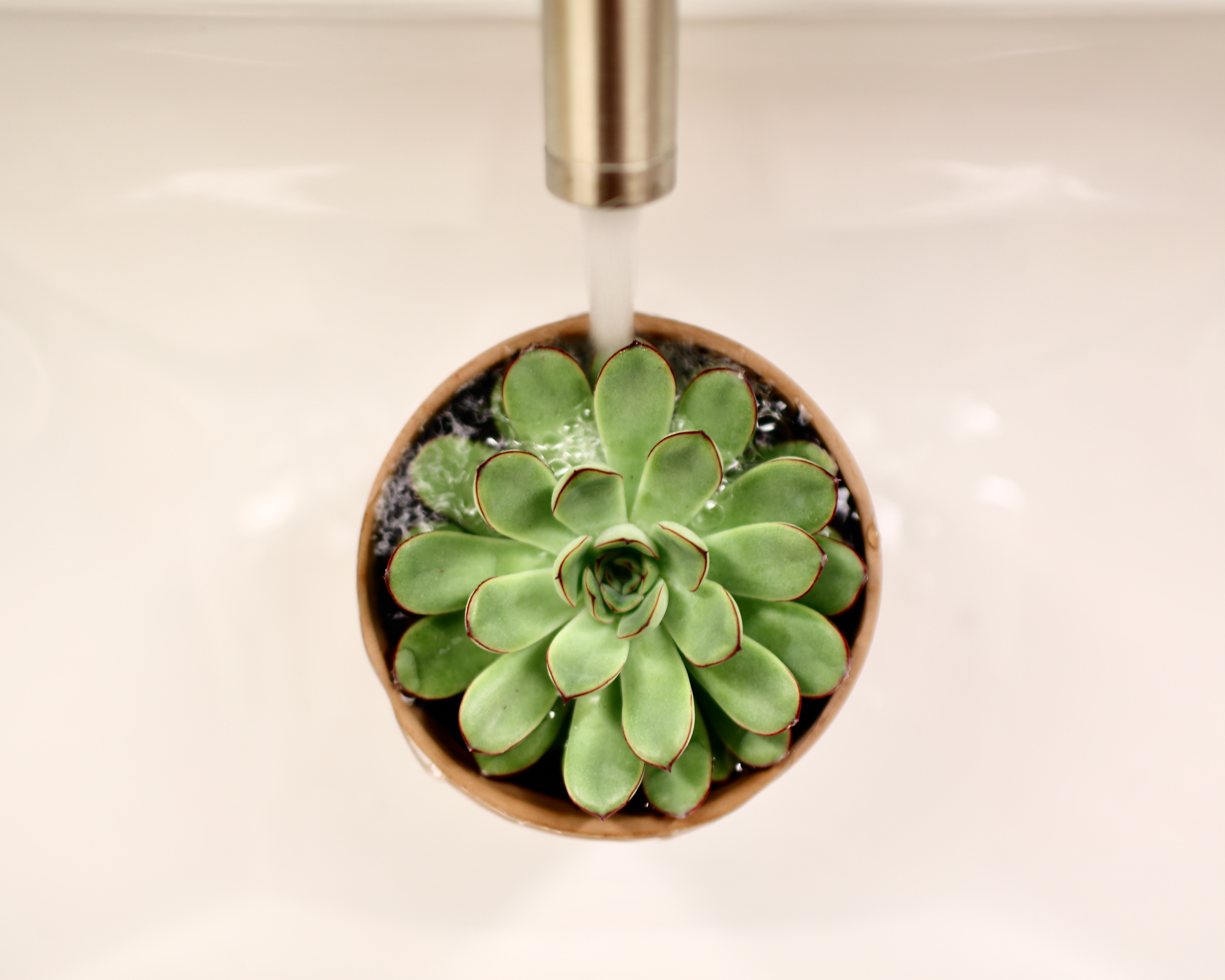Are you concerned that your succulent is not doing well? Learn how to diagnose if it is dying due to over- or under-watering and what to do to save it in this post!
When you buy something from this website, we may receive a commission. This will not add any extra cost to you. The commission we make helps us to continue to give you free content.
I often receive emails from worried succulent enthusiasts inquiring about why their plants are not thriving. In some cases, there’s actually nothing wrong with their succulents.
At times, it can be difficult to determine if a plant has been over- or under-watered. In this post, I’m going to provide some helpful tips to help you diagnose the issue.
If you want to make sure you’re taking good care of your succulents, I suggest you download my free cheat sheet. It will provide you with information on when to give your plants more or less water. Click the link to get it; it will be very useful.
Table of Contents
Keep track of watering…
I usually inquire about when the last time a person watered their succulent when they tell me it is not doing well.
Typically, they don’t have the answer!
I understand how tedious it can be to remember to water your succulents, but it is worth the effort if you want to keep them healthy and alive for longer.
I have found that the Succulent Tracker app (available on Apple and Android) is the simplest way to keep track of my collection of succulents, which has grown to more than 300! Rather than relying on paper and pen, or a spreadsheet, or even jotting down notes on my phone, this app is the best way for me to keep track of my plants.
Within the application, you can document information about your succulents such as titles, hydration, transplanting, pest treatment, images, etc.
I strongly suggest getting the app (Apple | Android) and logging each time you water your succulents. If the app is not an option, make sure to track the watering in some other way so you have useful data to help figure out what’s going on with your plants.
Now, let’s move on to the diagnosis!
Dried out, dying leaves
It is important to remember that it is natural for all plants, including succulents, to shed their leaves. This does not necessarily mean that your succulent is dying or that you are not caring for it properly.
If the lower leaves of your succulent have become dried out, it is probably still in good condition, but may require a bit more frequent watering.
As your plant matures, new leaves will sprout while the older ones wither away. It’s typical to find some dead, dried leaves at the base of the plant, so don’t panic if this is the case.
If a majority of your succulents leaves have become withered and dry, that is a sign that it needs more frequent watering.
If you find the dried leaves on your plant to be unattractive, simply remove them from the base of the plant and discard them. Make sure to keep the plant in its pot when you take away the leaves to avoid disturbing the roots.
Only remove the leaves that are already loose or dead. Let me demonstrate by taking the plant out of the pot to show you what dead leaves look like on a healthy plant.
Over-watering
Dead leaves at the base of your succulent are nothing to worry about, however if you start noticing dead leaves on the upper parts of newer growth, it may be a sign that you have either over- or under-watered the plant. Additionally, the soil the succulent is planted in could also play a role in its health, which is discussed further in this article.
If your plant’s leaves have taken on a yellowish hue and become translucent, and feel soft and squishy when touched, it is likely a sign of overwatering.
If you see leaves dropping off your succulent with only slight pressure, it is an indication that you are overwatering it. If the stem of the plant has become black or there are mushy spots on the stem or leaves, the over-watering is more serious, and it may be hard to bring the succulent back to health.
This Donkey’s Tail succulent has been overwatered, causing the center plant to rot. You can see the black stems and mushy leaves that have been affected.
Echeverias are particularly prone to water damage and can quickly deteriorate when given too much water in a short period of time. These plants can be especially sensitive to over-watering and can begin to rot after only two or three days of excess water.
In this video, I provide a step-by-step guide on how to identify and treat issues with my succulents.
How to save an over-watered succulent with a black stem
If you spot signs of overwatering on one of your plants, reduce the frequency of watering and consider changing the soil mixture. Ensure that the pot you’re using has a drainage hole for any excess water.
If your succulent has a black stem or black spots, you can try to salvage it by trimming away any affected areas. Leave the cutting out to dry for three to five days, and then replant it in fresh soil. This process is much simpler than it seems!
I trimmed away all sections of the stem that were soggy or discolored.
I advise taking out the decaying succulent from the group of succulents in order to prevent any potential damage to the other plants. It is best to remove the affected plant from the arrangement.
Under-watering
I’ve observed that Portulacaria afra and Senecio haworthii require more frequent watering than other succulents, which can be an issue in addition to the more commonly known problem of over-watering.
If the leaves of your succulents are beginning to appear wrinkled and dry, it’s likely time to provide them with some extra water. As an example, here is a Mesembryanthemum lehmanni that has never been watered.
I put the plant in a decorative concrete planter without a drainage hole, so I did not water it when initially planting and then completely forgot about it.
With regular watering, this succulent should be back to its normal condition within a couple of weeks.
How to save an under-watered succulent
In general, reviving an under-watered succulent is simpler than attempting to save one that has been overwatered. If your plants are just beginning to show signs of wilting, they should be able to be revived with one or two good waterings. However, if your succulents have become severely shriveled, it is unlikely that they can be brought back to life.
To help succulents bounce back after being under watered, it is important to give the soil a deep soaking when you water. Refer to my post on how to water succulents for the best results.
If you’re feeling daring and perhaps in a pinch, you can try hydroponic therapy for parched succulents. However, this should only be done as a last resort.
Don’t forget to obtain my complimentary cheat sheet so you can recognize when it’s time to give your succulents more or less water. This will help you stop potential issues before they arise. Click here to access the cheat sheet.
I wish that by recognizing the signs and symptoms of hydration issues, you’ll be able to rescue your succulent before it’s too late.
Other problems
While over- or under-watering is usually the most frequent issue new succulent owners grapple with, there are some other potential problems they may encounter, such as stretching out, infestation with bugs, and internal infections.
This is a common inquiry I receive – why are the lower leaves of my succulent turning yellow or brown? This video will provide insight into what is typical for succulents and what is not.
You can also check out my page on common succulent issues to get more information on how to figure out what’s wrong with your succulent. Time is of the essence, so make sure to identify the problem quickly to improve your chances of saving your plant.
By paying close attention to your succulents, you can identify any potential issues early on, allowing you to take corrective action before the situation escalates.
FAQ
Should I cut off dying succulent leaves?
Taking away the dried leaves under your plants will give them air circulation and make the soil dry out faster. Doing this in humid or wet climates can help stop your plants from getting rot, mildew, or other diseases.
How do I know if my succulent is dying?
Your succulent leaves may appear yellow, transparent, or soggy, which indicates the start of its demise from overwatering. Brown or black leaves that seem to be decaying is a sign of a more severe issue and it’s time to start taking measures to save your succulent.
What does overwatered succulent look like?
Overwatered succulents may produce large, swollen leaves with a yellow or light brown tinge that appear almost transparent. These leaves are dead and will eventually fall off and decompose.
What does a dying succulent look like?
A succulent that is decaying will have blackened leaves at the base of its stem and stem that are either brown or black and soft to the touch.


